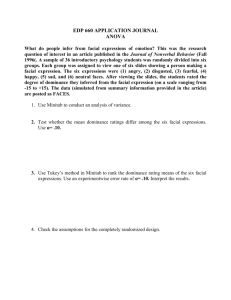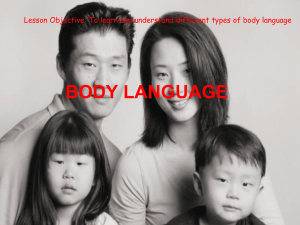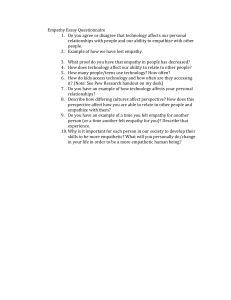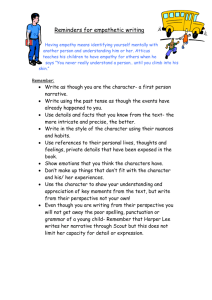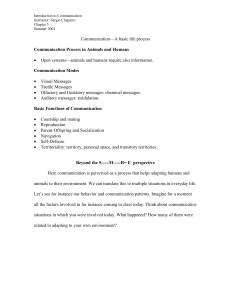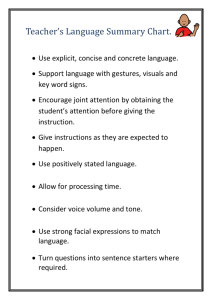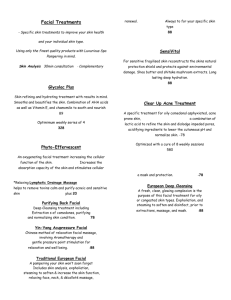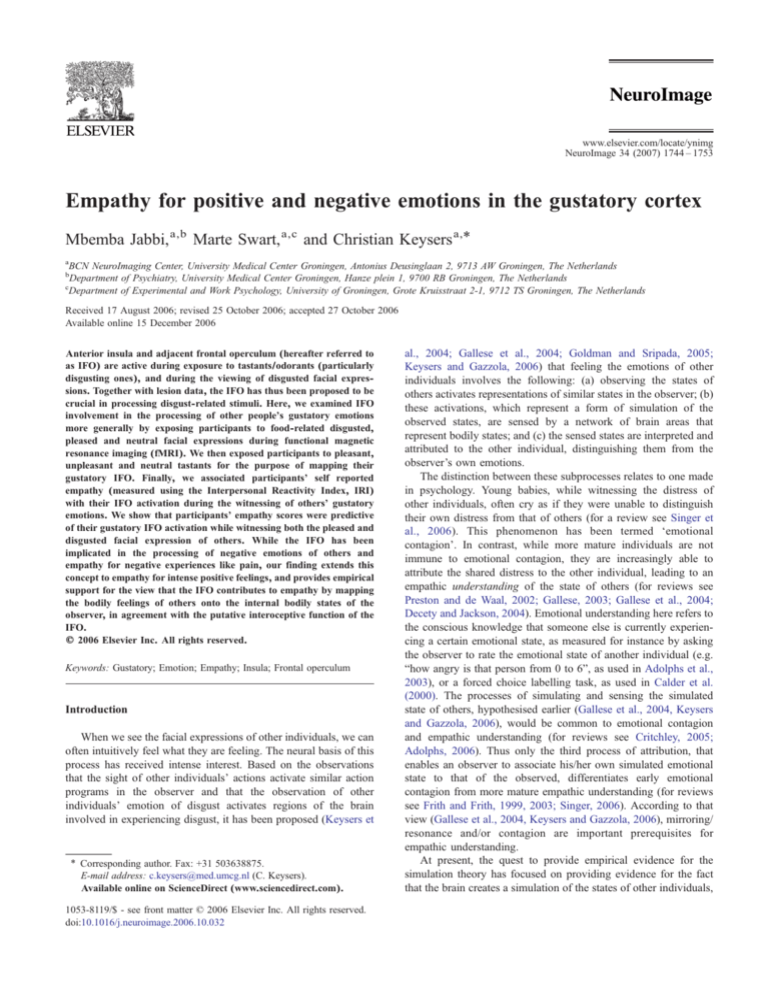
www.elsevier.com/locate/ynimg
NeuroImage 34 (2007) 1744 – 1753
Empathy for positive and negative emotions in the gustatory cortex
Mbemba Jabbi, a,b Marte Swart, a,c and Christian Keysers a,⁎
a
BCN NeuroImaging Center, University Medical Center Groningen, Antonius Deusinglaan 2, 9713 AW Groningen, The Netherlands
Department of Psychiatry, University Medical Center Groningen, Hanze plein 1, 9700 RB Groningen, The Netherlands
c
Department of Experimental and Work Psychology, University of Groningen, Grote Kruisstraat 2-1, 9712 TS Groningen, The Netherlands
b
Received 17 August 2006; revised 25 October 2006; accepted 27 October 2006
Available online 15 December 2006
Anterior insula and adjacent frontal operculum (hereafter referred to
as IFO) are active during exposure to tastants/odorants (particularly
disgusting ones), and during the viewing of disgusted facial expressions. Together with lesion data, the IFO has thus been proposed to be
crucial in processing disgust-related stimuli. Here, we examined IFO
involvement in the processing of other people’s gustatory emotions
more generally by exposing participants to food-related disgusted,
pleased and neutral facial expressions during functional magnetic
resonance imaging (fMRI). We then exposed participants to pleasant,
unpleasant and neutral tastants for the purpose of mapping their
gustatory IFO. Finally, we associated participants’ self reported
empathy (measured using the Interpersonal Reactivity Index, IRI)
with their IFO activation during the witnessing of others’ gustatory
emotions. We show that participants’ empathy scores were predictive
of their gustatory IFO activation while witnessing both the pleased and
disgusted facial expression of others. While the IFO has been
implicated in the processing of negative emotions of others and
empathy for negative experiences like pain, our finding extends this
concept to empathy for intense positive feelings, and provides empirical
support for the view that the IFO contributes to empathy by mapping
the bodily feelings of others onto the internal bodily states of the
observer, in agreement with the putative interoceptive function of the
IFO.
© 2006 Elsevier Inc. All rights reserved.
Keywords: Gustatory; Emotion; Empathy; Insula; Frontal operculum
Introduction
When we see the facial expressions of other individuals, we can
often intuitively feel what they are feeling. The neural basis of this
process has received intense interest. Based on the observations
that the sight of other individuals’ actions activate similar action
programs in the observer and that the observation of other
individuals’ emotion of disgust activates regions of the brain
involved in experiencing disgust, it has been proposed (Keysers et
⁎ Corresponding author. Fax: +31 503638875.
E-mail address: c.keysers@med.umcg.nl (C. Keysers).
Available online on ScienceDirect (www.sciencedirect.com).
1053-8119/$ - see front matter © 2006 Elsevier Inc. All rights reserved.
doi:10.1016/j.neuroimage.2006.10.032
al., 2004; Gallese et al., 2004; Goldman and Sripada, 2005;
Keysers and Gazzola, 2006) that feeling the emotions of other
individuals involves the following: (a) observing the states of
others activates representations of similar states in the observer; (b)
these activations, which represent a form of simulation of the
observed states, are sensed by a network of brain areas that
represent bodily states; and (c) the sensed states are interpreted and
attributed to the other individual, distinguishing them from the
observer’s own emotions.
The distinction between these subprocesses relates to one made
in psychology. Young babies, while witnessing the distress of
other individuals, often cry as if they were unable to distinguish
their own distress from that of others (for a review see Singer et
al., 2006). This phenomenon has been termed ‘emotional
contagion’. In contrast, while more mature individuals are not
immune to emotional contagion, they are increasingly able to
attribute the shared distress to the other individual, leading to an
empathic understanding of the state of others (for reviews see
Preston and de Waal, 2002; Gallese, 2003; Gallese et al., 2004;
Decety and Jackson, 2004). Emotional understanding here refers to
the conscious knowledge that someone else is currently experiencing a certain emotional state, as measured for instance by asking
the observer to rate the emotional state of another individual (e.g.
“how angry is that person from 0 to 6”, as used in Adolphs et al.,
2003), or a forced choice labelling task, as used in Calder et al.
(2000). The processes of simulating and sensing the simulated
state of others, hypothesised earlier (Gallese et al., 2004, Keysers
and Gazzola, 2006), would be common to emotional contagion
and empathic understanding (for reviews see Critchley, 2005;
Adolphs, 2006). Thus only the third process of attribution, that
enables an observer to associate his/her own simulated emotional
state to that of the observed, differentiates early emotional
contagion from more mature empathic understanding (for reviews
see Frith and Frith, 1999, 2003; Singer, 2006). According to that
view (Gallese et al., 2004, Keysers and Gazzola, 2006), mirroring/
resonance and/or contagion are important prerequisites for
empathic understanding.
At present, the quest to provide empirical evidence for the
simulation theory has focused on providing evidence for the fact
that the brain creates a simulation of the states of other individuals,
M. Jabbi et al. / NeuroImage 34 (2007) 1744–1753
with current evidence suggesting that the observation of the
negative states of others triggers neural activations that resemble
those associated with experiencing similar negative states. Both
the observation of disgusted facial expressions and the experience
of disgust activate the anterior insula and the adjacent frontal
operculum, which will jointly be referred to as IFO (Phillips et al.,
1997; Zald et al., 2002; Small et al., 2003; Wicker et al., 2003;
Dapretto et al., 2006). The IFO is also activated when participants
observe facial expressions of pain, know a loved one is in pain or
experience pain themselves (Singer et al., 2004, 2006; Decety and
Jackson, 2004; Botvinick et al., 2005; Jackson et al., 2006; Lamm
et al., in press; Saarela et al., in press), with the participants that
report having more empathic concern activating their IFO more
strongly while aware of others’ pain (Singer et al., 2004, 2006). In
addition, lesions in the IFO impair both the experience of disgust
(Adolphs et al., 2003) and the understanding of other people’s
disgust (i.e. impaired labelling of facial and vocal expressions of
disgust) (Calder et al., 2000; Adolphs et al., 2003). Together these
experiments converge to ascribe a pivotal role for the IFO in the
network of brain areas that underpin the process of simulating
observed states of others making the insula a likely neural
structure important both for emotional contagion and empathic
understanding.
The IFO has also been identified as essential for sensing
one’s own visceral bodily state (Craig et al., 2000; Critchley et
al., 2001, 2002, 2003, 2004, 2005; for reviews see Damasio,
1996, Craig, 2002, 2003; Critchley, 2005), with people more
able to sense their own heart beat showing stronger IFO
responses (for a review see Critchley, 2005). Altogether, the IFO
might therefore be engaged in two aspects that are key to
simulation: the activation of simulated states, and the sensing of
one’s own state, be it simulated or experienced (Keysers and
Gazzola, 2006). In addition, the IFO has been shown to have the
pattern of efferent and afferent connections necessary for
performing both tasks (Mesulam and Mufson, 1982a,b; Mufson
and Mesulam, 1982).
Is the IFO confined to the processing of negative states, such
as pain and disgust, or does it also process positive states, as
long as the latter are associated with the visceral sensations that
the IFO is thought to represent? The ingestion of pleasant foods
and liquids, associated with such positive bodily states, provide a
way to test this prediction that has, to our knowledge, so far not
been explored. We therefore scanned participants while they
viewed short movie clips of actors sipping from a cup and
displaying either an intensely pleased, intensely disgusted or a
neutral facial expression. Subsequently, we then scanned the
same participants while ingesting pleasant (sucrose), unpleasant
(quinine) and neutral (artificial saliva) solutions to map their
gustatory IFO.
Individuals differ in their sensitivity to the feeling states of
others, and these differences can be measured using self-report
questionnaires, such as the Interpersonal Reactivity Index (IRI,
Davis, 1980). Here, we measured participants’ IRI scores and
then searched for regions that respond more strongly to the
gustatory experiences of others in participants with higher IRI
scores. We restricted such a search to participants’ functionally
defined gustatory IFO. As argued previously (Singer et al.,
2004, 2006; Gazzola et al., 2006) this approach searches for
areas underpinning our inter-individual variation in transforming
the states of other people into our own, a process thought to be
essential for emotional contagion and empathic sharing.
1745
Materials and methods
Participants and procedures
The institutional review board of the University Medical Center
Groningen approved the study. Thirty-three healthy volunteers free
from any known gustatory, olfactory, visual, neurological or
psychiatric disorders gave written informed consent and participated in a screening and training sessions. Participants were
screened for their taste sensitivity using labeled magnitude scaling
(LMS) (Green et al., 1996), for the goal of excluding super/non
tasters during the initial rating of the quinine and sucrose solutions
as reported earlier (Small et al., 2003). We used quinine and
sucrose for the taste screening with the participants reporting their
perceived taste intensity on the LMS scale, ranging from 0 (barely
detectable) to 100 (strongest imaginable). As we examine the
influence of empathy on interindividual differences in brain
activity, it is important to keep other sources of variance in check.
In accordance with other studies (Small et al., 2003), we therefore
restricted our experiments to participants in the normal range of
tasting. Normal tasters were defined as those whose score for
sucrose fell within the range of 15–75; while the normal tasting for
quinine was define by scores ranging from 30 to 75. Normal tasting
scores were obtained for all but 10 participants (9 non tasters and 1
super taster) who were excluded from fMRI. Of the remaining 23
participants that were scanned, two were excluded because of
excessive movement, two for not being able to follow the taste and
swallow instructions and one because of a vomiting spell. The final
sample included in the analysis consisted of 18 right-handed
healthy individuals (10 females; mean age 24, SD 2.64) as
classified by the Edinburgh scale (Oldfield, 1971). Participants
were questioned to ensure they were ignorant about the aim of the
study before the event-related fMRI sessions (see Figs. 1 and 2).
Visual runs
Visual runs consisted of the observation of disgusted, pleased
and neutral facial expressions (see Fig. 1). Actors were recruited
from the Noord Nederlands toneel and the Jeugd theatre school,
Groningen. They were asked to taste the content of a cup and
express their resulting emotion in a naturally vivid manner (see
Fig. 1). A separate group of 16 individuals rated the facial
expressions of all the edited movies in terms of the intensity,
naturalness and vividness of pleased, disgust, and the neutral
expressions they recognized for each movie on a 7-point Likert
scale. The 10 best clips for each emotional category in terms of the
intensity, naturalness and vividness of expression of the emotions
(as rated by the 16 individuals) for the three emotional conditions
were selected for the final experiment. Each visual run contained
all of the final selected 30 movie clips (3 s each, 10 movies per
condition × 3 conditions) presented in a randomized event-related
fashion with a red fixation cross between two movie clips.
Gustatory runs
Participants sampled and rated the intensity and pleasantness/
unpleasantness of quinine (unpleasant taste) with a concentration
of 1.0 × 10− 3 M and sucrose (pleasant taste) with a concentration of
1.8 × 10− 2 M as used previously (Small et al., 2003). The neutral
taste consisted of artificial saliva (Saliva Orthana; Farmachemie
BV Haarlem, the Netherlands; art no. 39.701.130) diluted with
1746
M. Jabbi et al. / NeuroImage 34 (2007) 1744–1753
Fig. 1. Gustatory visual stimuli. Above are picture frames of three sample movies portraying actors while tasting concentrated citric acid (shown in the first row)
leading to the experience (expression) of disgust, water (middle row) portraying an neutral gustatory experience and orange juice (last row) leading to the
experience (facial expressions) of pleasure. Each movie shows an actor holding a cup and eventually sipping the content by means of a plastic straw (∼ 1 s) as can
be seen in column (A). This was followed by the actor releasing the straw and simultaneously swallowing the liquid (column B), and finally, the actor then
expresses a neutral, pleased, or disgusted facial expression (∼2 s) shown in column C. During the visual experiment, 10 movie clips for each emotional category
was presented with a red fixation cross between each movie lasting for a variable duration of 8–12 s in a fully randomized event-related fashion. Two repetitions
of the original run were present in a fully randomized event-related design.
distilled water to a subject-specific neutral taste (participants chose
the most neutrally tasting solution from concentrations of 5%, 10%
and 20% artificial saliva in water). In the fMRI experiment, taste
solutions were delivered as a 0.5 cm3 bolus over a 5-s period
(Small et al., 2003). The solutions were delivered by an
experimenter standing beside the MRI scanner using a tubing
system that consisted of a syringe (for each taste condition)
connected to a 45-cm infusion tube that was inserted into a pacifier
through a perforation at the top with the tip of the tube protruding
slightly through the sucking tip of the pacifier (see Fig. 2). Taste
instructions were given before scanning using water. Regardless of
the strong unpleasant sensations as a result of the quinine delivery,
the data obtained from the realignment procedure confirmed that
all but two participants (excluded from the study for this reason)
did not move their heads in reaction to the taste solutions for more
than 1 mm.
Fig. 2. Gustatory procedures. Procedures involving presentation of auditory instructions to the experimenter (shown with a tie). Visual instructions were
presented to the subject (shown supine). At the start of the experiment, participants saw a black screen (lowest row), the experimenter simultaneously hears a
voice instructing him to deliver either quinine, sucrose or artificial saliva (depending on the trial at hand) by means of the 5-ml syringe connected to the tubing
(upper row). Timing of delivery of the taste and rinsing solutions was controlled with a voice counting from three to start as in Keysers et al. (2004) (middle row).
For each individual taste stimulus, delivery of the solutions coincides with the presentation of a cross that follows the black screen, instructing subjects to keep the
liquid in their mouth and taste it. This is followed by the text “swallow!” appearing on the screen, instructing participants to swallow the liquid. The experimenter
then receives another auditory instruction to deliver the rinsing water, the delivery of which coincides with a visual instruction to the subject to rinse their mouth,
followed by an instruction to swallow the rinsing solution. For each run, a total of three deliveries for each taste condition were carried out, and a total of four taste
runs were presented in a fully randomized slow event-related fashion with a black screen being presented between two consecutive stimuli with variable
durations of 4–6 s. A total of 12 conditions (3 × 4) were modeled for final analysis (i.e., 3 tasting conditions for quinine, sucrose and saliva; 3 swallowing of these
tasting conditions; 3 rinsing of these tasting conditions and 3 swallowing of the rinsing solutions).
M. Jabbi et al. / NeuroImage 34 (2007) 1744–1753
Self-report measures
We rated participants’ subjective reaction to the sight of others’
gustatory emotions by asking how willing they are to drink some
of the beverage the individuals in the movies just tried (from − 6
‘absolutely not’ to 6 ‘very much’) see Fig. 3b. Furthermore, we
asked participants to rate the quinine, sucrose and neutral solution
that they had to ingest during the experiment on a scale ranging
from − 6 ‘extremely disgusting’ to 6 ‘extremely delicious’. Both
scales measure participants’ evaluation of the beverages involved
in the third person (He tastes) and first person perspective (I taste)
of the experiment, and thus allow a direct comparison of these two
perspectives. Additionally, the IRI (Davis, 1980) was administered
to assess participant’s interpersonal reactivity index.
1747
participants, high-pass filters with cut-off points at 106 s and 310 s
for the visual and gustatory conditions, respectively, were included
in the filtering matrix in order to remove low-frequency noise and
slow drifts in the signal, which could bias the estimates of the error.
Condition-specific effects at each voxel were estimated using the
general linear model. Single participant’s t contrast maps and
random effects analyses were carried out (Wicker et al., 2003).
Furthermore, a simple regression analysis (using the individual
scores of each IRI subscale and individual disgust sensitivity
scores as a predictor) of the activations of the whole brain was
carried out at the second level using the basic models function in
SPM2 and a statistical threshold of p < 0.005 (uncorrected) (see
Table S2).
Functional definition of the gustatory IFO
fMRI acquisition
Images were acquired using a Philips 3T whole-body scanner
(Best, The Netherlands) equipped with a circular sense head coil.
For functional imaging, we used a T2*-weighted echo-planar
sequence with 39 interleaved 3.5 mm thick axial slices with 0 mm
gap (TR = 2000, TE = 30 ms, flip angle = 80°, FOV = 224 mm,
64 × 64 matrix of 3.5 × 3.5 × 3.5 mm voxels). At the end of the
functional scans, a T1-weighted anatomical image (1 × 1 × 1 mm)
parallel to the bicommissural plane, covering the whole brain was
acquired.
General fMRI data analysis
Data were preprocessed and analyzed using Statistical Parametric Mapping (SPM2; Wellcome Department of Cognitive
Neurology, London, UK; http://www.fil.ion.ucl.ac.uk). All functional volumes were realigned to the first acquired volume. Images
were coregistered to the participant’s anatomical space and spatial
normalization was then carried out on all images (Friston et al.,
1995) to obtain images with a voxel size of 2 × 2 × 2 mm). All
volumes were then smoothed with an 8 mm full-width halfmaximum isotropic Gaussian kernel. For time series analysis on all
We defined the gustatory IFO functionally using the data from
the taste experiment. We calculated at the second level, the
contrasts quinine–saliva and sucrose–saliva, thresholded both
contrasts individually at p < 0.005 (uncorrected) and applied a
logical OR. The resulting map thus included all voxels involved in
tasting (be they positive of negative) relative to saliva. Since this
map included more than the IFO, we additionally required that
voxels had MNI coordinates in the following range: X = (22 to 70
or − 70 to − 22), Y= (− 4 to 40) and Z = (− 20 to 18). The resulting
map is shown as Fig. S1, and was used as an inclusive mask for the
correlation analyses between participant’s IFO activation during
the viewing of facial expressions of other’s gustatory experiences
and their own tendency to empathise with others as measured by
the IRI scale.
Correlation analysis
To identify correlations between empathy and visual activations
in the IFO, for each subject, we calculated the parameter estimates
for viewing disgusted, pleased and neutral facial expressions
separately. Using a separate simple regression model at the second
level, we then searched for voxels in which a correlation between
the individuals’ IRI score and parameter estimate for each of the
facial expressions existed. These maps where inclusively masked
with the gustatory IFO mask. This analysis was performed for the
total IRI score (composite IRI), and separately for each of the four
subscales (i.e., empathic concern ‘EC’, Fantasy ‘FS’, perspective
taking ‘PT’ and personal distress ‘PD’).
Additional analyses within identified clusters of correlation
were performed using Marsbar (http://marsbar.scourceforge.net;
M. Brett, J.-L. Anton, R. Valabregue, and J.-B. Poline, 2002, Region
of Interest analysis using an SPM toolbox, Abstract).
Results
Ratings
Fig. 3. Mean subjective ratings ± SEM of how disgusting/delicious the
liquids were perceived by participants during tasting of quinine, sucrose and
artificial saliva (taste ratings blank bars) and ratings of ones' willingness to
drink the liquids they saw the actor drinking (visual ratings black bars).
Participants were asked to rate the taste experience of others in their own
person-relevant perspective (i.e., how willing they were to taste the drink
they saw the actors just took), this way, we could judge the affective states
the facial expressions induced in them by means of their willingness/
unwillingness ratings as a result of the perceived pleasure/disgust.
In order to determine how much the emotional facial
expressions in the movies affect the participants, we rated their
subjective reaction to the gustatory emotions depicted in the films
by asking how willing they would be to drink some of the beverage
the individuals in the movies just tried (from − 6 ‘absolutely not
willing’ to 6 ‘very much willing’); see Fig. 3. Furthermore, we
asked them to rate the quinine, sucrose and neutral solutions that
they had to ingest during the experiment on a scale ranging from
1748
M. Jabbi et al. / NeuroImage 34 (2007) 1744–1753
− 6 ‘extremely disgusting’ to 6 ‘extremely delicious’. Both the
willingness and the direct taste rating scales measure participants’
evaluation of the beverages (albeit from different perspectives),
and were therefore directly compared using a repeated measurement ANOVA with 2 perspectives (tasting vs. viewing) × 3
beverages (unpleasant, pleasant and neutral).
This analysis revealed a main effect of perspective (F(1,17) =
9.9, p < 0.006), with tasting leading to more negative ratings than
observing and a main effect of beverage (F(2,34) = 184, p < 10− 18)
were observed. Importantly, there was no interaction of perspective
and beverage (p < 0.386), suggesting that the difference between
the beverages was similar for the two perspectives. During tasting
however, quinine was rated as more disgusting than sucrose as
pleasant (p < 0.001, after comparing absolute values by changing
the negative scores for quinine into positive scores). This
phenomenon has been reported earlier (Wicker et al., 2003;
Nitschke et al., 2006), and explained as related to differences in
perceived intensity as well as valence (Small et al., 2003; Liberzon
et al., 2003). Finally, post-hoc examination (Newman–Keuls)
shows that negative and positive stimuli were rated as more
negative and more positive respectively than neutral stimuli (all
p < 0.001).
Neuroimaging results
To identify the relationship between individual’s gustatory IFO
responses to the gustatory experience of others during the
witnessesing of these experiences, we correlated individuals’ IRI
scores with their brain activations during the viewing of other’s
gustatory emotions. The IRI is a 28-item with a 5-point Likert-type
scale (0 = does not describe me well to 4 = describes me very well)
that assesses four dimensions of empathy: FS, PD, PT and EC
(Davis, 1980, 1994). To restrict our analysis to the gustatory IFO
we masked these correlation maps with the functionally defined
gustatory IFO (see Materials and methods and Fig. S1).
As a first step, we analysed correlations with the composite IRI
obtained from summing the scores obtained on the four distinct
subscales. Fig. 4 shows that positive correlation exist between this
composite IRI and the parameter estimates obtained during the
vision of disgusted facial expressions, in both the right and left
gustatory IFO. In the left IFO, similar correlations were observed
between the vision of pleased facial expressions and the composite
IRI. Correlations with neutral facial expressions were smaller, and
restricted to the right hemisphere.
The composite IRI pools data from four different subscales
measuring different aspects of empathy, and it has been advocated
that a better approach stems from examining the individual
contribution of each subscale (D’Orazio, 2004). We therefore
examined the pattern of correlation observed for each individual
subscale.
Both the PD and FS scales correlated significantly with visual
activations during the observation of both the disgusted and pleased
facial expressions of others in bilateral gustatory IFO (Fig. 5A–B).
The center column of Fig. 5A–B shows this spatial pattern of
correlation. Voxels shown in red correlated with the empathy scores
while viewing disgusted faces, but not while viewing neutral or
pleased faces; voxels shown in white correlated with the empathy
scores during both the vision of pleased and disgusted facial
expressions, but not during the vision of neutral facial expressions.
No other combination of correlations was observed within the IFO
for the PD and FS scales. To examine the nature of the correlational
relationship further, we extracted the mean BOLD signal from the
compound clusters of correlations (combining the white and red
voxels circled in the figure), and calculated parameter estimates for
all visual and gustatory conditions (see graphs in the right and left
column of Fig. 5). For both scales, and both hemispheres,
parameter estimates for the vision of pleased and disgusted facial
expressions correlated significantly with the empathy measures at
p < 0.005 if the entire cluster was considered (Fig. 5A and B, left
column). The right column illustrates the overall trend in these
clusters if the low and highly empathic participants are combined,
and shows that over all, their mean activations to pleased and
disgusted facial expressions were extremely similar.
For PT and EC scores, the link to the visual brain activations
was less clear. None of the voxels in the gustatory IFO had visual
activations that correlated with the EC scale during the vision of
any facial expressions. For PT, only one cluster (relatively smaller
than the ones predictive for PD and FS) in the right gustatory IFO
correlated significantly with the parameter estimate for viewing
disgust and neutral, but not pleased, facial expressions (shown in
red in Fig. 5C). Results of whole brain–IRI correlations are
reported in the Supplementary data (Table S1).
To test if our correlations of empathy with IFO activation
during the viewing of others gustatory experience is specific for the
Fig. 4. Composite IRI scores (i.e., total scores on the whole IRI questionnaire) predicted IFO activations during the observation of different facial expressions.
Results show voxels where the correlation between the parameter estimate obtained during the vision of the facial expression and the composite IRI was
significant at p < 0.005, uncorrected, and the cluster contained at least 5 contiguous voxels. Results were masked with the gustatory IFO. Results are overlaid on
the mean T1 image of the 18 participants.
M. Jabbi et al. / NeuroImage 34 (2007) 1744–1753
1749
Fig. 5. Empathy and the IFO. Center column: voxels showing significant correlations between individuals' IRI subscales and parameter estimates derived during
the observation of disgusted, pleased or neutral facial expressions (see text for colour coding). Results were thresholded at p < 0.005 uncorrected at the voxel
level, and masked with the gustatory IFO. The mean signal in the compound cluster of correlation was then extracted, and further analysed in the left and right
column, showing the relationship between participants' IRI score (x-axis) and visual parameter estimates (y-axis) together with regression line and correlation
value on the left, and mean parameter estimated during vision and taste (±SEM) on the right. The color-coding for the right and left columns defined in panel C
applies to all panels. Our results of FS- and PD-predicted activations in IFO during the viewing of disgusted faces, and PD-predicted cluster during the viewing of
pleasure survived FDR correction at p < 0.05. The FS-predicted activations during the viewing of pleased faces also survived FDR correction at p < 0.075 while
the PT-predicted IFO activation during the viewing of disgusted and neutral faces did not survive FDR corrections.
1750
M. Jabbi et al. / NeuroImage 34 (2007) 1744–1753
viewing condition, we performed a similar correlational analysis
between participants’ individual IRI sub-scale scores and their IFO
activation during the experience of disgusting and pleasant taste.
We found no significant correlations in the IFO between
individuals’ IRI scores and their IFO activations during tasting
making our empathy-related IFO findings specific for the
observation of social gustatory experiences of others.
Within all five empathy-correlating clusters outlined in Fig. 5,
during vision, pleasant and disgusted facial expressions seemed to
cause similar average activations, both of which exceeded that
observed during the viewing of neutral faces. We performed a 5
cluster × 3 faces ANOVA to examine this effect. The analysis
revealed no significant interaction between cluster and faces
indicating that the effect of stimulus was similar in all clusters. A
planned comparison between pleased and disgusted faces showed
no significant difference (F(1,17) < 0.33, p > 0.57), while both
emotional faces caused stronger activations than the neutral faces
(F(1,17) > 6.56, p < 0.02). During tasting, the same analysis
revealed a different pattern of activation: quinine exceeded both
saliva and sucrose in activation (both p < 0.02), and sucrose did not
differ from saliva (p > 0.6).
Discussion
Here, we examined whether the gustatory IFO activations
during the vision of pleased and disgusted facial expressions
correlated with how participants scored on a self report measure
of their sensitivity to other people’s feeling states (IRI). We
found that for both pleased and disgusted facial expressions,
participants that obtained higher scores in the PD and FS
subscales of the IRI activated their functionally defined gustatory IFO more strongly than participants obtaining lower scores.
This relationship was less prominent in the case of PT and EC
scores.
These results demonstrate for the first time, that during the
vision of facial expressions of other people’s gustatory emotions,
the amplitude of activations in the gustatory IFO go hand-in-hand
with differences in self reported interpersonal reactivity. This
finding extends our previous demonstration, that the IFO contains
voxels involved in the experience and the observation of negative
states such as disgust (Wicker et al., 2003), and provides further
support for the hypothesis that the IFO activation during emotion
observation may represent a transformation of observed states into
experienced emotional states (Wild et al., 2001; Hess and Blairy,
2001; Lawrence et al., 2005; Saarela et al., in press; for reviews see
Damasio, 1996; Craig, 2002; Gallese et al., 2004; Critchley, 2005;
Singer, 2006). In addition, by using a correlation approach, we
provide the first demonstration that the IFO is involved in the
processing of positive states of other individuals.
A number of studies have suggested that the insula is
particularly involved in the processing of negative states, including
disgust and pain (Phillips et al., 1997; Calder et al., 2000; Adolphs
et al., 2003, Wicker et al., 2003; Singer et al., 2004, 2006; Jackson
et al., 2005; Botvinick et al., 2005; Lamm et al., in press, for
reviews see Calder et al., 2001; Adolphs, 2003). In contrast, others
have shown that the insula is also important for the experience of
positive visceral states such as positive tastes and flavours (Zald et
al., 2002, Small et al., 2003; O’Doherty et al., 2006; Nitschke et al.,
2006; for a review see Phan et al., 2002) and a PET study has
shown preliminary evidence for the fact that the vision of bodily
pleasure in others causes activations of the Insula (movies of
pleasant heterosexual coitus, Stoleru et al., 1999). Our current
study extends these findings to positive food-related pleasure and
suggests a link between these activations and interpersonal
reactivity. It thereby confirms the involvement of the IFO in the
processing of both the positive and the negative states of others.
The pain, disgust and bodily pleasure that have been found to
activate the insula so far all involve sensations triggered by
strongly somatic stimuli such as food, electroshocks or sexual
stimulation. Further research will be needed to test whether states
such as primary disgust/distaste-, pain-, food- and sex-related
pleasure do rely on the IFO because they are associated with a
somatic trigger.
Our finding that different subscales of the IRI differ in their
correlation with visual activations requires some consideration.
According to Gallese et al. (2004) and Keysers and Gazzola (2006)
the sight of the states of others: (a) triggers similar states in the
observer, which are then (b) sensed, and eventually (c) attributed to
the other individuals. The IFO is thought to contribute mainly to
the first two stages of this process. If this is true, IFO activity
should correlate primarily with subscales of the IRI that tap into the
sharing of feeling states (i.e. emotional contagion). The FS
subscale taps directly into respondents’ ability to transpose
themselves into the feelings and behaviors of actors in movies
(Davis, 1980, 1994). The PD subscale measures people’s
emotional arousability-related to both negative and positive
emotions (Eisenberg et al., 1991; Davis, 1994). Both scales thus
measure interindividual differences in emotional contagion and the
fact that these scales were found to correlate with the activations in
the IFO thus supports the view that the IFO may be part of a
network that maps the states of others onto similar states in the
observer (Critchley et al., 2002, 2003, 2004: for reviews see
Gallese et al., 2004; Keysers and Gazzola, 2006; Critchley, 2005).
Based on our results, it is impossible to conclude whether the role
of the IFO is primarily to activate a state resembling that of the
observed subject or to sense and feel that simulated state. It
remains for future research to test the hypothesis that the
involuntary sharing of observed states is common to emotional
contagion and empathic understanding.
The EC and PT scales on the other hand tap into aspects that go
beyond the sharing of feeling states of others. The EC subscale
focuses on sympathy for ‘victims’ (people less fortunate, people
that are taken advantage of, people treated unfairly). Participants
scoring high on EC thus do not primarily respond to the sight of
the misfortunes of others with states directly resembling those
observed (which would be rage, pain or fear), but with sympathy.
This involves a process that according to simulation theories would
occur after a simulated state has been sensed and attributed to
another individual. While negative findings should always be
interpreted with caution, the stronger correlation between PD and
IFO activation compared to EC might relate to two aspects. First,
EC might be more related to the function of other structures.
Second, our actors were not prototypical victims: they voluntarily
tried a variety of drinks, making most of the questions in the EC
subscale irrelevant to our movies. In support of this latter
interpretation, Singer et al. (2004) showed that when the stimuli
relate to the pain inflicted by someone else to a loved victim (i.e.,
an electroshock), EC scores do predict activations in a region that
overlaps with our IFO findings. Finally, the PT subscale mainly
measures interpersonal reactivity from a more cognitive, emotionally neutral perspective that taps into people’s voluntary attempts to
understand the goals and motivations of other people (Davis, 1980,
M. Jabbi et al. / NeuroImage 34 (2007) 1744–1753
1994). Here we focused on the gustatory IFO to examine the
function of this structure. The stronger correlation with PD and FS
and the weaker correlation with PT and EC suggest that this
structure is primarily involved in the involuntary sharing of
observed states common to emotional contagion and empathic
sharing (as measured by PD and FS). The IFO thus appears less
involved in the more deliberate concern or cognitive perspective
taking that requires an explicit and mature concept of self and
other. Other areas of the insula, the anterior cingulate and other
limbic structures appear more involved in these latter processes
(see Table S2).
The present report focused on the role of the IFO in social
cognition. However, our findings of positive correlations between
individual’s IRI scores and activations of other brain areas outside
of the functionally defined IFO, such as the medial prefrontal and
posterior cingulate cortices, thought to mediate social cognitive
processes such as theory of mind (e.g. Saxe and Powell, 2006; for
reviews see Frith and Frith, 1999; Saxe, 2006; Amodio and Frith,
2006) are of importance. The medial prefrontal cortex in particular
is believed to be important in mentalizing, i.e. thinking about the
mental states of others. It is activated both when participants reflect
about their own emotions (Gusnard et al., 2001) and when they
reflect about the mental states of others (see Frith and Frith, 2003
for a review). The fact that our empathy correlations involve both
the IFO and structures such as the medial prefrontal cortex suggest
that the mapping of observed bodily states onto similar states of the
self (in the IFO) might go hand in hand with mentalizing about ones
own states and those of others (in the medial prefrontal cortex). The
interaction of these brain areas may be critical in transforming sheer
emotional contagion into a conscious understanding of other
individuals’ mental states (see Keysers and Gazzola, 2006). Further
research will be required to examine the connectivity between these
areas and disentangle the intricate relationship between emotional
contagion, simulation and mentalizing.
By capitalizing on inter-individual differences in empathy, we
show that the regions of the IFO involved in the processing of our
own sensation of drinking are activated both when participants
witness other individuals drinking pleasant and disgusting
beverages. These findings suggest that the role of the IFO in the
representation of bodily states of others is broader than previously
thought (Craig et al., 2000; Critchley et al., 2001, 2002, 2003,
2004, 2005; Krolak-Salmon et al., 2003; for reviews see Damasio,
1996, 1999; Craig, 2002; Churchland, 2002; Preston and de Waal,
2002; Gallese et al., 2004; Critchley, 2005; Adolphs, 2006;
Keysers and Gazzola, 2006) and not limited to negative emotions.
The fact that our activations depended on differences in
interpersonal reactivity expands the original observation of a link
between IFO activity and empathy for pain (Singer et al., 2004,
2006) to gustatory pleasure and disgust/distaste and strengthens the
link between activations in these areas and our ability to share
other people’s emotions. The human bilateral IFO may constitute a
critical component of the neural mechanism that allows the
mapping of the bodily states of others onto our own inner states
and thereby facilitate our understanding of the social environment
and ultimately survival. How strongly individuals mirror socially
relevant bodily experiences may depends on the reactivity of their
inner milieu (as measured by disgust sensitivity scales etc.) or their
capacity to sense their inner milieu (as measure for instance by
alexithymia scales). Future experiments will need to disentangle
these processes and to determine the neural basis of the interaction
between emotional contagion and empathic understanding.
1751
Acknowledgments
The authors thank the participants for their time, Anita Kuiper
and Remco Renken for help in the acquisition of data, Dana
Small for information on the chemosensory stimuli, Marina
Maura and Johan van der Heiden for the preparation of the
chemosensory stimuli, and Christian van der Gaag for the
acquisition of the visual stimuli. We thank Tania Singer, Vittorio
Gallese and John O’Doherty for their valuable comments. The
research was supported by a Nederlandse Organisatie voor
Wetenschappelijk Onderzoek (NWO) VIDI grant to CK and a
Marie Curie Excellence Grant to CK, as well as an NWO grant
no. 904-53-092 to Johan A den Boer and Johan Ormel. MJ
conceived and designed the study, acquired and analysed the data
and wrote the paper. CK contribute equally to conceiving the
study, performing data analysis and writing the paper. MS
contributed equally to acquiring the data. We thank all members
of the social brain lab for valuable comments on earlier versions
of the manuscript.
Appendix A. Supplementary data
Supplementary data associated with this article can be found, in
the online version, at doi:10.1016/j.neuroimage.2006.10.032.
References
Adolphs, R., 2003. Cognitive neuroscience of human social behaviour. Nat.
Rev., Neurosci. 4, 165–178.
Adolphs, R., 2006. How do we know the minds of others? Domainspecificity, simulation, and inactive social cognition. Brain Res. 1079,
25–35.
Adolphs, R., Tranel, D., Damasio, A.R., 2003. Dissociable neural systems
for recognizing emotions. Brain Cogn. 52, 61–69.
Amodio, D.M., Frith, C.D., 2006. Meeting of minds: the medial frontal
cortex and social cognition. Nat. Rev., Neurosci. 7, 268–277.
Botvinick, M., Jha, A.P., Bylsma, L.M., Fabian, S.A., Solomon, P.E.,
Prkachin, K.M., 2005. Viewing facial expressions of pain engages
cortical areas involved in the direct experience of pain. NeuroImage 25,
312–319.
Calder, A.J., Keane, J., Manes, F., Antoun, N., Young, A.W., 2000. Impaired
recognition and experience of disgust following brain injury. Nat.
Neurosci. 3, 1077–1088.
Calder, A.J., Lawrence, A.D., Young, A.W., 2001. Neuropsychology of fear
and loathing. Nat. Rev., Neurosci. 2, 352–363.
Churchland, P.S., 2002. Self-representation in nervous systems. Science
296, 308–310.
Craig, AD., 2002. How do you feel? Interoception: the sense of the
physiological condition of the body. Nat. Rev., Neurosci. 3,
655–666.
Craig, AD., 2003. Interoception: the sense of the physiological condition of
the body. Curr. Opin. Neurobiol. 4, 500–505.
Craig, A.D., Chen, K., Bandy, D., Reiman, E.M., 2000. Thermosensory
activation of insular cortex. Nat. Neurosci. 3, 184–190.
Critchley, H.D., 2005. Neural mechanisms of autonomic, affective, and
cognitive integration. J. Comp. Neurol. 493, 154–166.
Critchley, H.D., Mathias, C.J., Dolan, R.J., 2001. Neuroanatomical basis for
first- and second-order representations of bodily states. Nat. Neurosci. 4,
207–212.
Critchley, H.D., Melmed, R.N., Featherstone, E., Mathias, C.J., Dolan, R.J.,
2002. Volitional control of autonomic arousal: a functional magnetic
resonance study. NeuroImage 16, 909–919.
1752
M. Jabbi et al. / NeuroImage 34 (2007) 1744–1753
Critchley, H.D., Good, C.D., Ashburner, J., Frackowiak, R.S., Mathias, C.J.,
Dolan, R.J., 2003. Changes in cerebral morphology consequent to
peripheral autonomic denervation. NeuroImage 18, 908–916.
Critchley, H.D., Wiens, S., Rotshtein, P., Ohman, A., Dolan, R.J., 2004.
Neural systems supporting interoceptive awareness. Nat. Neurosci. 7,
189–195.
Critchley, H.D., Rotshtein, P., Nagai, Y., O’Doherty, J., Mathias, C.J.,
Dolan, R.J., 2005. Activity in the human brain predicting differential
heart rate responses to emotional facial expressions. NeuroImage 24,
751–762.
Damasio, A.R., 1996. The somatic marker hypothesis and the possible
functions of the prefrontal cortex. Philos. Trans. R. Soc. Lond., B Biol.
Sci. 351, 1413–1420.
Damasio, A.R., 1999. The Feeling of What Happens: Body and Emotion in
the Making of Consciousness. Harcourt Brace, New York.
Dapretto, M., Davies, M.S., Pfeifer, J.H., Scott, A.A., Sigman, M.,
Bookheimer, S.Y., Iacoboni, M., 2006. Understanding emotions in
others: mirror neuron dysfunction in children with autism spectrum
disorders. Nat. Neurosci. 9, 28–30.
Davis, M.H., 1980. A multidimensional approach to individual differences
in empathy. Catal. Sel. Doc. Psychol. 10, 85 (MS. 2124).
Davis, M.H., 1994. Empathy: A Social Psychological Approach. Westview
Press, Colorado, p. 671.
Decety, J., Jackson, P.L., 2004. The functional architecture of human
empathy. Behav. Cogn. Neurosci. Rev. 3, 71–100.
D’Orazio, D., 2004. A comparative analysis of empathy in sexually
offending and non-offending juvenile and adult males. Sex. Abus. 16,
173–174.
Eisenberg, N., Fabes, R.A., Schaller, M., Miller, P., Carlo, G., Poulin,
R., Shea, C., Shell, R., 1991. Personality and socialization correlates
of vicarious emotional responding. J. Pers. Soc. Psychol. 61,
459–470.
Friston, K.J., Holmes, A.P., Worsley, K.J., Poline, J.B., Frith, C.D.,
Frackowiak, R.J.S., 1995. Statistical parametric maps in functional
imaging: a general linear approach. Hum. Brain Mapp. 3, 189–210 b.
Frith, C.D., Frith, U., 1999. Interacting minds—A biological basis. Science
286, 1692–1695.
Frith, U., Frith, C.D., 2003. Development and neurophysiology of
mentalizing. Philos. Trans. R. Soc. Lond., B Biol. Sci. 358,
459–473.
Gallese, V., 2003. The roots of empathy: the shared manifold hypothesis
and the neural basis of intersubjectivity. Psychopathology 36,
171–180.
Gallese, V., Keysers, C., Rizzolatti, G., 2004. A unifying view of the basis of
social cognition. Trends Cogn. Sci. 8, 396–403.
Gazzola, V., Aziz-Zadeh, L., Keysers, C., 2006. Empathy and the somatotopic
auditory mirror system in humans. Curr. Biol. 16, 1824–1829.
Goldman, A.I., Sripada, C.S., 2005. Simulationist models of face-based
emotion recognition. Cognition 94, 193–213.
Green, B.G., Dalton, P., Cowart, B., Shaffer, G., Rankin, K., Higgins, J.,
1996. Evaluating the ‘Labeled Magnitude Scale’ for measuring
sensations of taste and smell. Chem. Senses 21, 323–334.
Gusnard, D.A., Akbudak, E., Shulman, G.L., Raichle, M.E., 2001. Medial
prefrontal cortex and self-referential mental activity: relation to a
default mode of brain function. Proc. Natl. Acad. Sci. U. S. A. 98,
4259–4264.
Hess, U., Blairy, S., 2001. Facial mimicry and emotional contagion to
dynamic emotional facial expressions and their influence on decoding
accuracy. Int. J. Psychophysiol. 40, 129–141.
Jackson, P.L., Meltzoff, A.N., Decety, J., 2005. How do we perceive the pain
of others? A window into the neural processes involved in empathy.
NeuroImage 24, 771–779.
Jackson, P.L., Brunet, E., Meltzoff, A.N., Decety, J., 2006. Empathy
examined through the neural mechanisms involved in imagining how I
feel versus how you feel pain. Neuropsychologia 44, 752–761.
Keysers, C., Gazzola, V., 2006. Towards a unifying neural theory of social
cognition. Prog. Brain Res. 156, 383–406.
Keysers, C., Wicker, B., Gazzola, V., Anton, J.L., Fogassi, L., Gallese, V.,
2004. A touching sight: SII/PV activation during the observation and
experience of touch. Neuron 42, 335–346.
Krolak-Salmon, P., Henaff, M.A., Isnard, J., Tallon-Baudry, C., Guenot, M.,
Vighetto, A., Bertrand, O., Mauguiere, F., 2003. An attention modulated
response to disgust in human ventral anterior insula. Ann. Neurol. 53,
446–453.
Lamm, C., Batson, D.C., Decety, J., in press. The neural substrate of human
empathy: effects of perspective-taking and emotion regulation. Journal
of Cognitive Neuroscience.
Liberzon, I., Phan, K.L., Decker, L.R., Taylor, S.F., 2003. Extended
amygdala and emotional salience: a PET activation study of positive and
negative effect. Neuropsychopharmacology 28, 726–733.
Lawrence, E.J., Shaw, P., Giampietro, V.P., Surguladze, S., Brammer,
M.J., David, A.S., 2005. The role of ‘shared representations’ in
social perception and empathy: an fMRI study. Neuroimage 29,
1173–1184.
Mesulam, M.M., Mufson, E.J., 1982a. Insula of the old world monkey: I.
Architectonics in the insulo-orbito-temporal component of the
paralimbic brain. J. Comp. Neurol. 212, 1–22.
Mesulam, M.M., Mufson, E.J., 1982b. Insula of the old world monkey: III.
Efferent cortical output and comments on function. J. Comp. Neurol.
212, 38–52.
Mufson, E.J., Mesulam, M.M., 1982. Insula of the old world monkey: II.
Afferent cortical input and comments on the claustrum. J. Comp. Neurol.
212, 23–37.
Nitschke, J.B., Dixon, G.E., Sarinopoulos, I., Short, S.J., Cohen, J.D.,
Smith, E.E., Kosslyn, S.M., Rose, R.M., Davidson, R.J., 2006. Altering
expectancy dampens neural response to aversive taste in primary taste
cortex. Nat. Neurosci. 9, 435–442.
O’Doherty, J.P., Buchanan, T.W., Seymour, B., Dolan, R.J., 2006.
Predictive neural coding of reward preference involves dissociable
responses in human ventral midbrain and ventral striatum. Neuron 49,
157–166.
Oldfield, R.C., 1971. The assessment and analysis of handedness: the
Edinburgh inventory. Neuropsychologia 9, 97–113.
Phan, K.L., Wager, T., Taylor, S.F., Liberzon, I., 2002. Functional
neuroanatomy of emotion: a meta-analysis of emotion activation
studies in PET and fMRI. NeuroImage 16, 331–348.
Phillips, M.L., Young, A.W., Senior, C., Brammer, M., Andrew, C., Calder,
A.J., Bullmore, E.T., Perrett, D.I., Rowland, D., Williams, S.C., et al.,
1997. A specific neural substrate for perceiving facial expressions of
disgust. Nature 389, 495–498.
Preston, S.D., de Waal, F.B., 2002. Empathy: its ultimate and proximate
bases. Behav. Brain Sci. 25, 1–20.
Saarela, M.V., Hlushchuk, Y., Williams, A.C., Schurmann, M., Kalso, E.,
Hari, R., in press. The compassionate brain: humans detect intensity of
pain from another’s face. Cereb. Cortex.
Saxe, R., 2006. Uniquely human social cognition. Curr. Opin. Neurobiol. 16,
235–239.
Saxe, R., Powell, L.J., 2006. It’s the thought that counts: specific brain
regions for one component of theory of mind. Psychol. Sci. 17,
692–699.
Singer, T., 2006. The neuronal basis and ontogeny of empathy and mind
reading: review of literature and implications for future research.
Neurosci. Biobehav. Rev. 30, 855–863.
Singer, T., Seymour, B., O’Doherty, J., Kaube, H., Dolan, R.J., Frith, C.D.,
2004. Empathy for pain involves the affective but not sensory
components of pain. Science 303, 1157–1162.
Singer, T., Seymour, B., O’doherty, J.P., Stephan, K.E., Dolan, R.J., Frith,
C.D., 2006. Empathic neural responses are modulated by the
perceived fairness of others. Nature 439, 466–469.
Small, D.M., Gregory, M.D., Mak, Y.E., Gitelman, D., Mesulam, M.M.,
Parrish, T., 2003. Dissociation of neural representation of intensity and
affective valuation in human gustation. Neuron 39, 701–711.
Stoleru, S., Gregoire, M.C., Gerard, D., Decety, J., Lafarge, E., Cinotti, L.,
Lavenne, F., Le Bars, D., Vernet-Maury, E., Rada, H., Collet, C.,
M. Jabbi et al. / NeuroImage 34 (2007) 1744–1753
Mazoyer, B., Forest, M.G., Magnin, F., Spira, A., Comar, D., 1999.
Neuroanatomical correlates of visually evoked sexual arousal in human
males. Arch. Sex. Behav. 28, 1–21.
Wicker, B., Keysers, C., Plailly, J., Royet, J.P., Gallese, V., Rizzolatti, G.,
2003. Both of us disgusted in my insula: the common neural basis of
seeing and feeling disgust. Neuron 40, 655–664.
1753
Wild, B., Erb, M., Bartels, M., 2001. Are emotions contagious? Evoked
emotions while viewing emotionally expressive faces: quality, quantity,
time course and gender differences. Psychiatry Res. 102, 109–124.
Zald, D.H., Hagen, M.C., Pardo, J.V., 2002. Neural correlates of tasting
concentrated quinine and sugar solutions. J. Neurophysiol. 87,
1068–1075.


